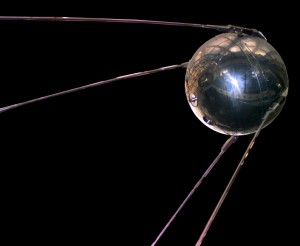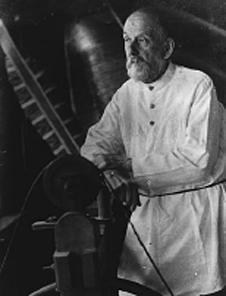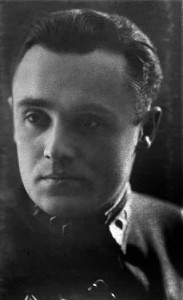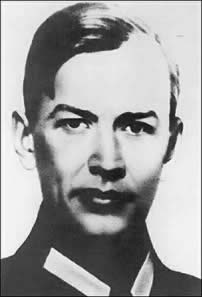Sputnik was the Soviets' Backup Satellite
Posted on Categories Discover Magazine

Wernher von Braun popped briefly back into his office before heading out to a pre-dinner reception. He’d spent the day giving General Bruce Medaris, head of the US Army Ballistic Missile Agency, and Neil McElroy, incoming Secretary of Defense, a tour of the facilities where his team was building America’s first intermediate range ballistic missile. But what von Braun really wanted was to use the same IRBM to launch a small satellite into orbit, ideally before the Soviet Union did the same. He had the mission worked out and even had a rocket — RS-29 — in storage ready to deploy on what he called Project Orbiter. What he didn’t have was political blessing. That honour had gone to the US Navy’s Vanguard program, the all-American effort von Braun thought had about a snowball’s chance in hell of beating the Soviets, if it managed to launch at all. The upcoming dinner was his last chance to convince McElroy to give his team the green light to ready their rocket for a shot at space once the Navy failed.
He was still in his office when the phone on the desk rang. A British voice on the line asked what he thought about it. Von Braun didn’t know what “it” was, and so the man tried again: “What do you think of the Soviet satellite that has just launched into orbit?”
Von Braun might have been more shocked if he hadn’t been reading the writing on the walls. For months reports from the Soviet Union had been hinting that a satellite program was under development, that scientists were closing in on a launch date. He’d been trying to American decision makers that space was a vital part of national defense, that a huge psychological victory would go to the first nation in orbit; within 24 hours he would be proved right on that count as well.
On the other side of the world, Soviet scientists in Khazakstan celebrated the news that was slowly sweeping around the world. Their satellite — SP-1 to them but Sputnik to the outside world — was in orbit. Though it was very early in the morning of October 5, the world would remember the date as it was on Moscow time. It took more than three years of planning and development, but bate at night on October 4, 1957, the Soviet Union launched the space age.
Though vanquished in the Second World War, the German Army produced one of the most notable technologies of the conflict. The A-4 rocket rechristened the V-2 by Goebbels’ propaganda machine was the first guided missile used as an offensive weapon, and both the United States and the Soviet Union captured the engineers behind it as a kind of intellectual reparations after the war’s end. And both countries had to establish new working groups and institutes where their new-found rocket knowledge could breed bigger and better rockets.
In May of 1946, the Soviet armaments industry founded Scientific-Research Institute 88 (simply written NII-88 and pronounced like “nee-88”) in Kaliningrad. Within NII-88 another group was founded, Scientific Research Institute No.4 (NII-4) with the directive to “investigate the development of methods of testing, acceptance, storage, and combat application of missile weaponry.” At the head of NII-4 was Mikhail Tikhonravov, a former of the early Soviet rocket society called GIRD (“Group for the Study of Reactive Motion”). When numerous departments within NII-88 were consolidated into a new design bureau called OKB-1 on April 26, 1950, the head of this unit for development of long-range missiles was another GIRD man, Sergei Pavlovich Korolev.
But the people leading and working in these bureaus weren’t strictly armaments people. Both Tikhonravov and Korolev were familiar with the writings of Konstantin Tsiolkovsky, the Russian grandfather of rocketry who’d worked out the math on how to launch satellites into space.
 It was perhaps no surprise then that it was NII-4 that took the Soviets’ first steps towards space. Engineers there were playing with the idea that they could put multiple rockets together to build something large and powerful enough to put a small satellite into orbit. In January of 1954, Tikhonravov compiled these early plans into a report on behalf of NII-4 and sent it to Korolev at OKB-1 who edited the document before passing it on to the Soviet Academy of Sciences for approval. In short order it was approved, and in the moths that followed a series of meetings determined the scientific payload of the future satellite.
It was perhaps no surprise then that it was NII-4 that took the Soviets’ first steps towards space. Engineers there were playing with the idea that they could put multiple rockets together to build something large and powerful enough to put a small satellite into orbit. In January of 1954, Tikhonravov compiled these early plans into a report on behalf of NII-4 and sent it to Korolev at OKB-1 who edited the document before passing it on to the Soviet Academy of Sciences for approval. In short order it was approved, and in the moths that followed a series of meetings determined the scientific payload of the future satellite.
The next step for Korolev was to secure political support, a vital step in securing funding that was made easier since his OKB-1 was also developing intercontinental ballistic missiles (ICBMs). In late May of 1954 he submitted a proposal titled “On the artificial satellite of the Earth” to Dmitry Ustinov, Minister of the Defense Industry along with a writeup of known American work on a similar satellite program. Korolev wrote that “the satellite is an inevitable stage on the path of the rocket development, which would make possible interplanetary travel.” He also echoed what von Braun was saying in the United States, that satellites were fast becoming of interest to foreign scientists, and that a nation with ability would do well to establish itself in this new arena.
A year later the satellite program had developed into one to design and launch a satellite “initially in the simplest configuration” relatively quickly. Using Tikhonravov’s early research, Korolev sought to establish a separate branch within OKB-1 to facilitate spacecraft development while keeping an eye on what the Americans were up to. Keeping it simple, he imagine having something ready to fly as early as the end of 1956, though it was still in the concept and proposal stage.
But nothing breeds technological innovation like competition. That spark came on July 29, 1955, when President Eisenhower announced the United States’ intention to launch a satellite as part of its International Geophysical Year activities, an 18-month period of international cooperative study into geophysical phenomena. Not to be outdone, the Soviets announced on August 3 at the Fourth Congress of the International Astronautics Federation that it would also launch a satellite as part of the IGY. Korolev’s proposal was to send a (3,300 – 6,600 pound (1,500 – 3,000 kilogram) satellite into orbit with the R-7 ICBM his OKB-1 was developing, something he wasn’t sure could match the rockets Wernher von Braun was building, but if the scientific payload was kept simple enough it could be done as early as 1957 or 1958. (A satellite that size would have dwarfed leading American plans for satellites as small as 3 pounds or 1.3 kilograms.)
With the American satellite promise official, it took just three days for the Central Committee Presidium to approve the satellite program as well as a series of sounding rockets as first steps before going into orbit. The news pleased Soviet premier Nikita Khrushchev, who boasted that the American satellite effort paled in comparison to what his Soviet scientists were working on.
Finally official, the satellite program was fine tuned in the months that followed. In September of 1955, the plan was to launch a 2,204 – 3,085 pound(1,000 – 1,400 kilogram) satellite identified as Object SP with 440 – 660 pounds (200-300 kilograms) of science instruments on board in the first half of 1957. At one point a smaller satellite called MSP was added to the plan, one that would launch on the smaller R-5 rocket as a demonstration.
Gradually the satellite plan came together, and on January 30, 1956, the program that would actually see the it built and launched was formally approved. It was decided the vehicle would have no attitude control for simplicity’s sake, and it was also given a designation. It was called Object D — Objects A, B, and V (based on the Cyrillic alphabet) were reserved for warhead configurations of payloads that would launch on the R-7.
Khrushchev’s excitement increased during a visit to OKB-1, though not because of the space applications. He saw at the design bureau a full mockup of the R-7, the rocket Korolev promised would being mainland America within the reach of the Soviets’ nuclear weapons. Seeing the premier’s glee, Korolev showed Khrushchev a mockup of a round satellite with antennas poking out from the centre an explained how it could reach orbit. Khrushchev, still most excited by the might of the R-7, gave Korolev his blessing for the satellite as part of the missile program. Thrilled, the engineer set his team on modifying an R-7 to carry a satellite to space rather than a nuclear bomb to America.
By July 1956, Object D was set to spends many as 12 weeks in space before its orbit decayed, though the lifespan would only be ten days owing to the available battery power and the limitations of the telemetry system. The satellite itself would weigh about 1,100 pounds (570 kilograms) and made of an aluminum alloy polished to a shine with four antennas to help with tracking. And as the final satellite configuration came together so too did the team behind it. Korolev managed to have a handful of his top picks, including Tikhonravov, transferred to OKB-1 to work on the satellite program by the end of the year.
 But around the same time, Korolev’s high hopes for Object D started to fall apart. There were problems developing the science payload and the R-7 was proving to be less powerful with a lower specific impulse than anticipated. All this threatened to push to launch back, closer to mid 1958 than early 1957. It would still fly within the timeframe of the IGY, but it meant the Americans would have a better chance to get up first. But there was another option: replace Object D with a smaller and even simpler satellite, something that wouldn’t yield as much data but could launch far sooner. Keeping the new plan even simpler was the idea of building almost everything in-house at OKB-1; the largest component provided by an external contractor would be the radio inside the satellite.
But around the same time, Korolev’s high hopes for Object D started to fall apart. There were problems developing the science payload and the R-7 was proving to be less powerful with a lower specific impulse than anticipated. All this threatened to push to launch back, closer to mid 1958 than early 1957. It would still fly within the timeframe of the IGY, but it meant the Americans would have a better chance to get up first. But there was another option: replace Object D with a smaller and even simpler satellite, something that wouldn’t yield as much data but could launch far sooner. Keeping the new plan even simpler was the idea of building almost everything in-house at OKB-1; the largest component provided by an external contractor would be the radio inside the satellite.
Pitched in November of 1956, the idea of a simpler first satellite gained tractions as 1957 dawned. In February the government got on board, agreeing to sanction this smaller, transmittal satellite designated Object PS just as soon as the R-7 could be proved reliable. Though it wasn’t going to be as functional, Korolev wanted to make sure the satellite still made an impact. So he settled on a planetary shape — a sphere — since it was going to be the first artificial plant in history. PS-1 was a far cry from Object D. It was a 22.8 inch (580 millimeter) diameter sphere with a skin just 2 millimeters thick made of highly-polished steel. Antennas poking out of it swept back as though blowing in the wind would deploy once it reached orbit, allowing scientists to track it. And it had to be perfectly shiny. Korolev famously had technicians in white gloves shine it until there wasn’t a scratch on its body. Any imperfections just wouldn’t do.
The R-7 rocket came to life, the satellite’s antenna deployment system was tested, and the fairing separation manoeuver was perfected. And all the while bits of information on the satellite plan leaked out, though it true Soviet fashion not all the details were correct. Headquarters of the IGY received a signed statement that a 20-inch (508 millimeter) sphere would be launching in polar orbit. The newspaper Pravda reported that a launch was months away, and Radio magazine offered frequencies and trajectories of future satellites so amateur ham radio operators could listen in. Towards the end of August, 1957, the Soviet news agency TASS announced the successful launch if a multistage intercontinental ballistic missile, the R-7. A mid-September announcement from Korolev himself at a scientific conference, like all the previously released tidbits, similarly failed to garner much excitement. No one really knew just how much work had been going on at OKB-1, though Korolev’s team had been working for almost three years to get this small satellite ready.
Finally, just days after that successful R-7 test flight in August, PS-1 was mated to its launch vehicle and the whole stack went through systems checks. A month later on September 22, the satellite and rocket arrived at the launch site at Tyuratam. Korolev arrived three days later to be on hand for the planned October 7 launch.
On October 1, Radio Moscow announced frequencies on which amateur radio operators could listen to SP-1’s signal. On October 2 the launch date was moved forward by three days in response to American reports that the US Navy’s Vanguard program was taking strides towards a launch; the Soviets weren’t going to let the Americans sneak in with a satellite launch of their own at the 11th hour, not after all the work they’d put in to fast-track this smaller option. In the morning of October 3, the R-7 with SP-1 on board was rolled onto the launch pad.
 Fueling began in the early morning hours of October 4 Moscow time; the launch site in Khazakstan is three hours ahead of the Russian capital with mission control sitting less than an hour away. The operation took most of the day; some time was lost unloading and reloading fuel after a spurious signal indicated a full load far too early.
Fueling began in the early morning hours of October 4 Moscow time; the launch site in Khazakstan is three hours ahead of the Russian capital with mission control sitting less than an hour away. The operation took most of the day; some time was lost unloading and reloading fuel after a spurious signal indicated a full load far too early.
At T-minus 15 minutes the gantries were moved safely to the side. Minutes later Korolev along with other launch officials took their places in the safety of the launch control bunker, watching through windows. At 10:28 in the evening of October 4 Moscow time — 1:28 in the morning in the morning of October 5 at the launch site — a technician pressed a button and the rocket lifted off the launch pad. The moment it was out of site, Korolev and the other officials ran from the bunker to their cars and drove to the nearby assembly building. There they watched as a technician matched telemetry signals against a stopwatch timer, manually confirming that the engine had cutoff on time. The powered flight was good, and before long he heard beeping sounds over the radio. Sputnik was in orbit, speaking the men who had put it there. The space age had begun.
A little less than a year later, Korolev did see his dream satellite launch, though it was maybe less impactful than he’d hoped. Object D eventually flew as Sputnik 3 on May 15, 1958. It was one of the less publicized early satellites but the mission Soviet scientists celebrated as their first truly scientific exploration of space.
Sources: Russian Space Web; Korolev by James Harford; Sputnik and the Soviet Space Challenge by Asif Siddiqi; Breaking the Chains of Gravity by Amy Shira Teitel, which you can buy right here and here!